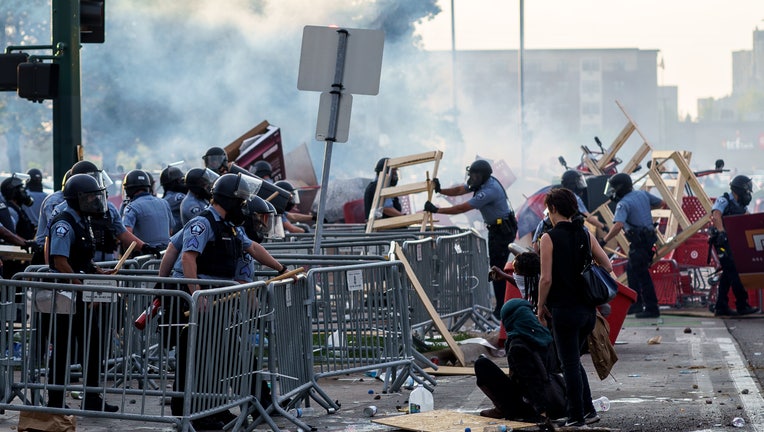Minnesota governor activates National Guard to restore calm amid escalating unrest over George Floyd death

Police remove barricades set by protesters during a demonstration over the killing of George Floyd by a policeman outside the Third Police Precinct on May 27, 2020 in Minneapolis, Minnesota. - Demonstrators gathered on May 27 for a second night of pr
(FOX 9) - Minnesota Gov. Tim Walz activated the Minnesota National Guard Thursday to help restore calm in the Twin Cities amid escalating unrest over the death of George Floyd, who died in the custody of Minneapolis police on Memorial Day.
According to a news release, the National Guard Adjutant General will work with local government agencies to provide personnel, equipment and facilities needed “to respond to and recover from this emergency.”

Minnesota governor activates National Guard to restore calm amid escalating unrest over George Floyd death
According to a news release, the National Guard Adjutant General will work with local government agencies to provide personnel, equipment and facilities needed
Minneapolis Mayor Jacob Frey asked the Walz to deploy the National Guard after protests turned violent Wednesday night, devolving into looting and rioting that has continued into Thursday and spread to St. Paul and surrounding suburbs.
Walz announced his decision shortly after 4 p.m. Thursday after a day-long discussion within his administration. The governor has not spoken publicly about the unrest in the state's biggest city in more than 24 hours, since the previous afternoon.
"The demonstration last night became incredibly unsafe for all involved," Walz said in an emailed statement about his decision. "The purpose of the National Guard is to protect people, to protect people safely demonstrating, and to protect small business owners.”
Mobilizing the National Guard is no easy task: the Guard is not a full-time military force, and many of its members live outstate. It's the first time the National Guard has been activated for a civil disturbance since 2008, when then-Gov. Tim Pawlenty called them up for the Republican National Convention in St. Paul.

Drone footage of widespread damage on East Lake Street following violent protests overnight
Drone video of the widespread damage on East Lake Street in Minneapolis Thursday morning after protesters set fires and ransacked businesses overnight.
Frey's request was met with backlash from some in the community. The Minneapolis NAACP tweeted that the Guard "is not needed" and that police needed to deescalate the unrest.
State Sen. Jeff Hayden, who represents parts of south Minneapolis that burned, also expressed reservations.
"The community has been traumatized because of law enforcement so continuing to add more and more law enforcement on that may not be the way to go. However, I do want people to be safe," Hayden, DFL-Minneapolis, told reporters Thursday.
In addition to National Guard soldiers, Walz said the Minnesota State Patrol will send 200 troopers to assist with public safety efforts over the next few days. Approximately 50-60 troopers were already in Minneapolis last night, according to a spokesperson for the governor’s office.
The executive order also declares a peacetime emergency, which activates the State Emergency Operations Center (SEOC) to help coordinate the state’s response.
"As the SEOC is already activated due to the COVID-19 pandemic, it will concurrently support the COVID-19 response and the City of Minneapolis and surrounding communities during this situation," according to a news release.

